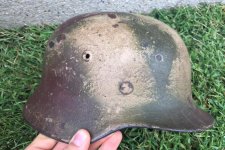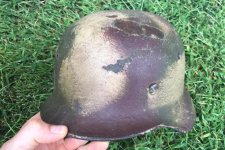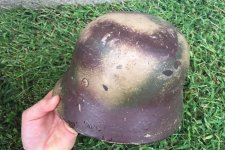Well this should get the paranoia going:... That 'paranoia' you speak of is there for a reason, because German helmet collecting has become besieged with a pandemic of fake camo helmets (among other types). There are so many fake camos in fact, that the chances of fake camos sitting in our own camo helmet collections are quite high. There are probably far more fake camo German helmets in the collecting world today than were ever brought home by GIs.
I agree, camos are dangerous, but i poke fun at your paranoia because its a bit extreme. I have yet to see you authenticate a single helmet, other than the ones you own of course. Dont get me wrong, details are important, but focus on the wave miss the ocean.
Joking aside, this one came out of an attic in Georgia recently where it had been abandoned.... Well, maybe it did. But such stories do not guarantee authenticity. I'm thinking of a particular fake M38 camo that was 'found' in a barn in Europe and praised by the throngs on the WAF forum some years back. The staging of a fake camo to be later 'found' is not difficult to do.
I search daily for these things. I paid less for this helmet and my other normandy than the base helmets themselves are worth. Also I'd appreciate it if you didnt insinuate that I lie.
Very vibrant textured camo... Vibrant colors on camos concern me, as 70 year old paint usually dulls down to some degree due to handling, age and the elements.
although the liner is much more frail in this one and the chinstrap has crumbled away.... Certainly not the 'kiss-of-death' but one should question why the camo paint is in such good condition while the other components are in such poor condition.
Quite simple, it sat in a dark dry environment, preserving the paint, yet drying out the liner.
If you look closely in the last picture you can see a fingerprint in the paint (no it isn't mine...  )
) Collectors should be aware that camo fakers are paying attention to the finer details and are including such 'nice touches' as applying a bit of camo paint to the liner or chinstrap as some originals have. The fingerprint is one of those 'nice touches'.
yes im sure someone went to the trouble of putting their fingerprint in the paint on a fake helmet they spent months creating to sell for less than a base M40 is worth.
Here's another one of my patented backyard fakes with wear not following prescribed patterns, wear around the rim, paint which isnt dead enough, and gouges and chips in paint which are random (imagine that) and around seemingly good paint. Definitely fake.... Joke if you want to, but it's your money that's at stake. Comparing the wear characteristics of known originals with those of suspect helmets can be a good indicator of authenticity, IMO. I do see quite a bit of good conditioned paint along with repetitive, heavy rub marks down to steel (disparity of wear).
Please define "known original". Is it something you yourself have deemed original? By your own definition, basically any story of how a helmet was found could be made up. So unless you picked up a helmet yourself in 1945 or before there are no known originals.
I have been very lucky as its my second in 8 months.... If you are on a camo buying spree you are playing a very dangerous game, my friend. Fakes and forgeries are intended to deceive, and range from crude to excellent. The so-called 'one-looker' helmets need to be given a second, more detailed look. In short, I do not see anything on this helmet that cannot be replicated by a competent restorer.
Camo buying spree? A bit presumptuous. I own 3 camos, 2 are normandies that, again, i paid for each of them less than the base helmet would be worth. Again, I dont buy from dealers or collectors. Every helmet I own I have sourced myself. I search daily, and it has taken 8 months since my last helmet to find this.
So, is this helmet real or fake? I can't say for certain. I deal in probabilities and possibilities. I examine all of the individual fine details and come to an overall conclusion.
With all due respect, I was not seeking your authentication. I already knew the answer, every camo is fake.
Positives: It looks great! But then again, forged currencies, forged masterpieces, and forged camo helmets all 'look great' because they are intended to deceive.
Negatives: A number of 'red flags' jump out; disparity of paint wear (excellent conditioned paint along side very heavy wear), disparity of component wear (excellent camo overall but with heavily worn components), vibrant paint colors (reflecting newness of paint), the Georgia attic story makes me suspicious.
if you think the components are heavily worn, you should look again. the liner looks only lightly worn, but has sat ignored for a long time.
Collectors should take the time to carefully weigh the pros and cons of any subject camo helmet and not be mesmerized by the 'one-looker' emotions that cause them to overlook the red flags.
 )
) )
) IMG_4521.jpg161.8 KB · Views: 199
IMG_4521.jpg161.8 KB · Views: 199 IMG_4522.jpg179.9 KB · Views: 149
IMG_4522.jpg179.9 KB · Views: 149 IMG_4524.jpg179.1 KB · Views: 143
IMG_4524.jpg179.1 KB · Views: 143 IMG_4525.jpg146.6 KB · Views: 144
IMG_4525.jpg146.6 KB · Views: 144 IMG_4527.jpg163.7 KB · Views: 126
IMG_4527.jpg163.7 KB · Views: 126 IMG_4532.jpg152.3 KB · Views: 124
IMG_4532.jpg152.3 KB · Views: 124 IMG_4533.jpg144.5 KB · Views: 105
IMG_4533.jpg144.5 KB · Views: 105 IMG_4528.jpg203 KB · Views: 113
IMG_4528.jpg203 KB · Views: 113 IMG_4530.jpg156.3 KB · Views: 108
IMG_4530.jpg156.3 KB · Views: 108 IMG_4534.jpg107.3 KB · Views: 119
IMG_4534.jpg107.3 KB · Views: 119




